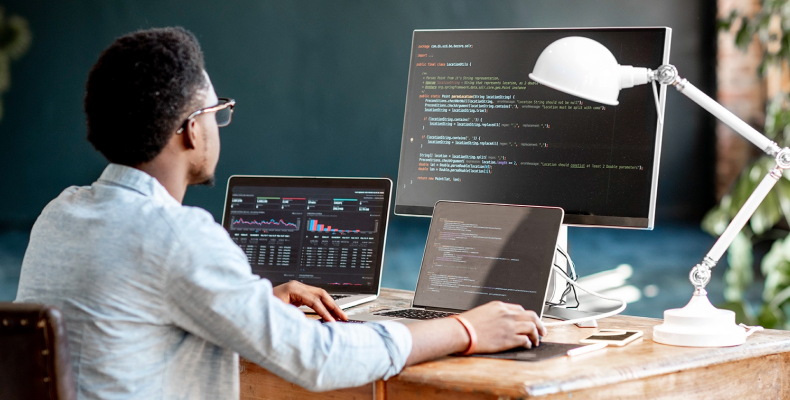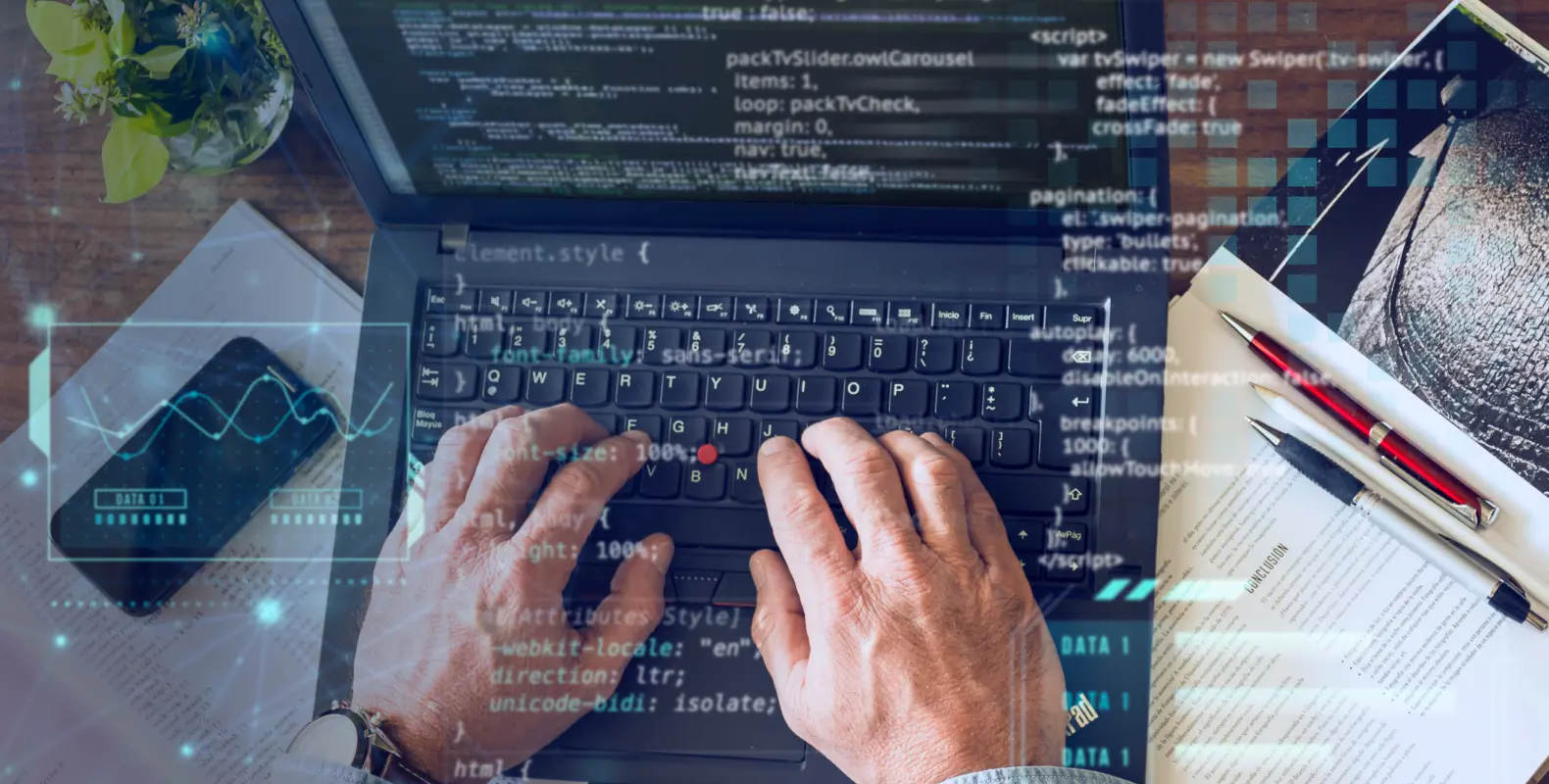We use cookies to ensure we give you the best experience on our website. By clicking Agree you accept our Privacy and Cookies Policy.
Legacy app modernization: A comprehensive guide

 20 minutes read
20 minutes read
Content
Legacy systems are a headache and, sometimes, a burden for product owners. Outdated apps are usually difficult and expensive to maintain. You need people familiar with old-school technologies to keep them afloat, and you need to invest time and money in making tiny changes or adjustments. What’s the decision? Legacy apps modernization.
From a tech side, the app becomes easy to maintain and update. From a business side, modernization saves money and allows your app to enter new markets sooner. In this analysis, we share the experience of our tech specialists and business analytics. We shed light on steps, strategies, and trends in legacy system modernization. Also, you’ll find out, how to understand that your app requires modernization and what to expect when it’s done.

What is legacy application modernization?
First, let’s define the legacy app. That’s a definition of a system, a piece of software, or a whole technology which does not integrate with new technologies and is, therefore, hard to maintain and support. Besides these difficulties, companies can not just abandon these systems. The first reason why is that they might be incredibly complex, and the development of a new similar system might cost a fortune. Also, the systems might be pillars of the business, and the transition to new ones might be risky. The process also requires educating people about new systems and time for polishing all the processes.
Legacy app modernization is updating the system entirely or partially. The aim is to include modern platform infrastructure, architecture, or features. It results in improved scalability and increased performance and functionality.
Why do businesses still use systems from the past?
Why do businesses continue to rely on legacy application systems despite the many difficulties and high costs associated with doing so? Why do they resist modernization so much? The reluctance or fear of change is a major contributing factor. Since we are, by nature, creatures of habit, not all of us are prepared to go out into the unknown to embrace the radical shifts necessary for successful digital transformation. Employees are frequently the ones who are unwilling to accept new technology and commit to novel procedures and applications. In addition, companies may choose to stick with outdated infrastructures because of a lack of funds. Concerns regarding the return on investment (ROI) of introducing new software might be a strong obstacle. Lock-in with a single vendor might be a problem as well. And if workers are already hostile to new systems, how can businesses ensure a return on investment (ROI) if they experiment with anything new? The decision to continue using outdated systems is partly a question of complacency. The old proverb goes something like this: “If it ain’t broke, don’t repair it.” If something is operating as intended, then there’s no reason to alter it. Why introduce new software and then have to educate people how to use it if they are already accustomed to utilizing such systems? Fear of failure is another reason that encourages people to stick with older technologies. Many businesses, especially those involved in banking and finance, can’t afford to lose data under any circumstances. Regardless of the reasons, we are now in the year 2025, and businesses have to adapt or risk falling behind.
Drawbacks of legacy software
Even while there are certain economic advantages to using legacy software, they pale in comparison to the problems that might arise from sticking with them. The issues of using outdated technology are discussed further on.
Failure to innovate
It is well-known that businesses are hampered in their efforts to improve by their reliance on outdated technology. Discomfort forces companies to focus on technological advancement and adaptation. The ramifications have a negative effect on company strategy and prevent companies from making the most of their working hours. Additionally, because strategy and operations are inflexible, legacy software keeps companies stagnant. Another obstacle for companies that want to allow employees to work remotely is the fact that many legacy software still rely on in-person interactions and data saved on local devices. There is a widening gap between new technologies and older infrastructures as yearly technological advancements accelerate. Both introducing a new technology and upgrading the current one may be a hassle for many companies.
Low levels of data security
Due to their age and absence of further development, legacy software poses security risks in several areas, including document security.
In addition, without consistent upkeep, vulnerable older software would not receive the latest security upgrades and patches they need. For this reason, any business, no matter its field, faces risks from insufficient data protection.
Not efficient in terms of cost
The cost of maintenance is yet another drawback of legacy software. Of course, there will be expenses associated with whatever system you implement but keeping legacy software running may be rather costly. First, it’s becoming increasingly difficult and more expensive to find developers and engineers who work with old software because most of them are keen on building their careers on cutting-edge tools.
Secondly, legacy software maintenance ensures that essential functions continue to be carried out, but there is little room for expansion in a stagnant infrastructure. The cost of upkeep for older software is a serious issue. If an organization does not effectively manage its outdated technology or replace it, it will incur additional expenditure. Legacy systems are often criticized for being inefficient and wasteful.
Incompatible and out of date procedures
As technology advances and shifts away from more traditional processes, legacy systems become less relevant. In addition, many companies prioritize effectiveness and the quality of their customers’ experiences. Therefore, having software that works well together is essential for delivering excellent service and/or goods.
For example, document automation is a modern business necessity that is not supported by outdated systems. In the long run, system upgrades may improve data accuracy and decrease processing times.
Why and when you should modernize legacy applications?
Now, let’s talk about markers of an outdated application. They signal you that it’s time to plan modernization.
First, pay attention to how much money you spend on maintaining your systems. If it becomes costly and the investments seem even higher in the future — that’s a red flag. Another one is that you struggle with integrating new features. This one is hard to ignore because you’ll need to make more and more such integrations in future.
Problems with security and compliance mean that legacy modernization is not even an option but a requirement. They question the possibility for you to use the app at all. It leads us to the next red flag — appearing obstacles to your business growth. If your development plan and your systems’ tech abilities don’t match, it’s time for updates.
You might miss some signals, but your users will also let you know if there are problems. If the user experience becomes insufficient or the app can’t withstand the competition — start thinking about modernization.
Listed below are five indicators that it is time for a change to the current era. If you notice that these issues exist, it may be time to push your business toward modernization.
1. High operating and upkeep expenses
When the upkeep of the current software is more expensive than the upgrade, the choice is obvious. Updates to increase efficiency may cost more up front, but they will save money in the long run.
And isn’t that truly the point? To make better use of time and resources. Because if you can increase your organization’s efficiency, you’ll be able to bring in more money and cover the price of any upcoming projects.
2. The software is simply… clumsy
Is there feedback from customers about the system’s usability? Are users’ efforts hindered by a process that requires many, time-consuming steps? Could it be described as sluggish?
If your software is clumsy, it’s probably old. Fitting a modernization plan to the demands of your company’s regular employees can increase output and boost morale.
3. Your company’s procedures have been altered
If you made your application choice some years ago, chances are that your company processes or the way your workers execute their jobs have evolved significantly since then. Furthermore, if the legacy system was designed to perform tasks “the old way,” it may prove challenging to integrate your new procedure with the software’s essential features.
4. No strong integration with potential future applications
It goes without saying that you’ll require seamless connection between the new apps and the legacy software if you plan on employing them in the future. However, if your existing vendor doesn’t have the necessary integrations and your IT department can’t develop them, modernization may be your only option.
5. It is not optimized for mobile devices
Your workforce will be more productive and efficient overall if they can access the software from anywhere, at any time. To be competitive in today’s business climate, mobile access must be supported by your system; otherwise, you’ll be stuck in the same inefficient, expensive setup you’re wanting to get rid of.
In order to ensure that as many people as possible have access to the system and take advantage of its features, it is important to invest in cloud-enabled, mobile-friendly solutions. By making this significant technological leap, you will see a surge in efficiency. Your staff will appreciate it as well.
What to expect from legacy app modernization?
Modernizing the legacy app helps to eliminate risks that arise from using outdated technology. It positively affects all the processes and workspaces. Employees and customers get a better user experience, loyalty grows, and you get more freedom in planning your growth goals. You will only see reductions in spending and maintenance efforts.
1. Flexibility to develop new features and services
Every business owner’s first consideration when selecting software for their operation is whether the program will serve their needs. However, businesses are adaptable, and they readily embrace new methods and ideas. However, it might be difficult for organizations to satisfy the expectations of current clients when the legacy technology they’re using becomes outmoded.
When an organization modernizes its applications, it gains the ability to develop and launch brand-new offerings that are perfectly tailored to the demands of the market at the present moment. Additionally, businesses may customize these functionalities to guarantee that older programs keep adding value.
2. Boosted employee productivity
If you stick with obsolete software, you should expect a decline in employee morale and output. In a similar vein, as a business expands, additional workforce is required. Thus, it is highly time-consuming and expensive to train people to use an older IT system.
However, with today’s technology, mundane tasks may be automated, and new workers can be trained quickly and efficiently. Additionally, if your administrative and development team has access to contemporary technology, they could be more effective than they were previously.
3. No technical debt
A company’s technical debts begin to accumulate when it is not prepared to update its legacy application. The inefficient software is riddled with issues including bugs, expensive application maintenance, and inability to scale.
It’s also impossible to fix one part of the legacy software without also affecting the others. It’s a huge drain on resources and slows down development.
It may be highly expensive to keep an aging IT software operational. However, market experts claim that updating the old tech might save companies as much as 13 % on operating expenses. In addition, their annual income might increase by more than 14%.
4. Enhanced customer experience
The market is flooded with companies selling essentially identical wares. In such a crowded marketplace, what sets your company or product apart from the rest? Statistics show that seventy-five to eighty-five percent of customers will pay more for an exceptional purchasing experience. Thus, we may conclude that providing a nice experience for the client is just as important as offering a reasonable price.
But, just due to the age of the legacy programs in use, customer service has declined. As a result, it might be challenging to offer a quick and effective solution for such uses.
However, you might benefit from the cloud environment while using current apps. The whole archive may be quickly restored from backup anytime it is needed. After you’ve updated your applications, your users won’t have any trouble finding their way around.
5. Improved safety measures
As new cyber threats emerge, there is a need to constantly review and upgrade the security measures in place inside older programs. A cyber-attack can cause you to lose not just your customers but also data that is crucial to running your business.
However, cloud-native apps provide cutting-edge security while saving significant amounts of both time and money. Therefore, you don’t have to exert as much work as you would with an older system.

The 7 Reasons of legacy modernization approach
Choosing the correct modernization strategy might be tricky. Each one has its place in a modernization initiative, and the choice depends on many factors, including business objectives, budget, time frames, and the current state of the app. Let’s look at 7 R’s of legacy app modernization:
Rehost
Often referred to as “lift and shift,” this strategy involves moving an app from its current hardware environment to a new one without making any change to its code. This is typical to migrating to the cloud. It is a quick and cost-effective way to start the modernization process, although it does not improve the app’s architecture, features, or performance.
Refactor
This strategy involves restructuring and optimizing the existing code without changing its external behavior. It is more about improving maintainability, scalability, or performance. Refactoring is essential when an app needs to align with new business requirements or technology standards.
Refactoring is the process of making changes to code in order to enhance it without affecting the code’s functioning. When done properly, software restructuring should have no noticeable effect on the user experience beyond speeding up responses.
Code refactoring can be done for a variety of reasons: for more convenience in upkeep, to increase its efficiency and speed up its operations, to make use of cutting-edge tools and industry standards.

Rearchitect
This approach significantly changes the application’s architecture while preserving its purpose and functionality. This might include moving from a monolithic architecture to a microservices architecture. Rearchitecting is necessary when your business wants to take advantage of newer capabilities, like better scalability or resilience.
In the history of software development, programs were typically created without future evolution in mind. When an app’s architecture doesn’t meet existing workload, speed, cost or reliability requirements, it’s time for a redesign. When you update the framework of your app, it’s easier to meet the evolving needs of your users.
Rebuild
This strategy involves completely rewriting or re-coding the app from scratch. Its scope and specifications remain unchanged. This is often chosen when the existing codebase is too outdated or complex and, therefore, can not be effectively refactored or rearchitected. Rebuilding an application allows using modern languages, frameworks, and best practices.
Having a well-thought-out user interface and user experience is crucial to the success of any software system. While updating your present UX/UI may seem like a tedious task, the benefits will extend well beyond aesthetics. It will boost business outcomes like customer satisfaction and retention rates.
Replace
As the name implies, this involves replacing the old application with a new one. This option is considered when the existing application is no longer viable to maintain or update. It is also an option for when there is a better solution available that meets the business needs.
Retire
In some cases, the best approach is to retire an old application. This is chosen when it no longer provides business value or is redundant due to other modernized apps. It involves a safe decommission of the old application and ensuring that necessary data is migrated to other systems.
Retain
Finally, there might be situations where the best decision is to retain the application as it is. This might an option is it still meets business needs or when modernisation costs outweigh the benefits.

Steps for modernization of legacy applications
App modernization might be time-consuming and complex. The process takes several steps, and each one reaches a different goal and provides a different value. Here is a generalized step-by-step approach to modernization.
- Assessment and planning. Begin by identifying which of your applications can be considered as legacy and require modernization. Understand the business needs and how these apps are aligned with your current and future business goals.
Assess the current state of these applications, including their architecture, technology stack, functionality, and performance. Consider any constraints and potential risks involved in the modernization process, including those time and budget related.
- Defining the strategy. Choose the appropriate modernization approach — one of the 7 R’s — for each application based on the assessment. Define clear objectives — what you aim to achieve through modernization. It might be improved performance, scalability, or cost savings.
Develop a detailed roadmap and timeline for the process.
- Preparation. Ensure you have the right skills and resources in-house. Provide training for your team, if needed, or hire a modernization partner.
Prepare the necessary infrastructure, especially if you are moving to cloud-based solutions. Make sure that the process aligns with relevant compliance standards and incorporates strong security measures.
- Modernization. Enrol the modernization process according to the chosen strategy. Use CI/CD pipelines for efficient and error-free deployment. Rigorously test the apps to ensure they meet quality standards and business requirements.
If your strategy involves moving data, plan how this will be done without data loss. Run the data migration, ensuring minimal downtime and impact on business operations.
- Monitoring and optimization. When the app is modernized, continuously monitor its performance. Collect feedback from users and stakeholders to understand the impact of the changes.
Keep optimizing your system for better performance, user experience, and cost-effectiveness.
- Documentation and training. Ensure all documentation is updated to reflect every change in the system. Conduct training sessions for your team and users to help them with getting used to the new features.
- Post-modernization review. Evaluate the success of the modernization project against the initial objectives and plan for any further improvements.

Trends in legacy application modernization
When kicking off the modernization process and conducting research, pay rigorous attention to the latest technology trends. This way, you make your app compatible with modern apps and make your product one hundred percent up-to-date. Among the trends to pay attention to at the beginning of 2025 are:
Cloud applications. Sharing data across multiple tools, users, and locations is never as easy as when using a cloud. It also positively impacts scaling and management, allows for agility and improves user experience. Last but not least, making updates takes minimum effort and minimum time.
Containers. While working in a cloud, use containers to deploy and operate your software. Containers ease management while being moved and distributed between environments. They also make apps more secure, efficient, and accessible.
Microservices. If the whole app is a tree, then microservices are bunches. They are the parts of one big system that operates for one big goal. However, each of these microservices is tied to deal with specific needs. They are interconnected by APIs and can be combined in different variations.
Automation. Many processes and actions can be automated to save time and improve productivity. A team can focus on more important tasks that require brainstorming or a creative approach.
DevOps. It is better for development and operations to work together. It improves overall operational efficiency and helps the business to stay on top. DevOps uses analytics, monitoring, and metrics to make strategic modernization decisions.
Data warehouses. The amount of data is growing and growing. Data warehouses store it, organize, and protect it. Thanks to these virtual houses, you can be sure that your valuable data will not end up in the wrong hands and will not get lost.
Conclusion
Legacy app modernization is not just a technological necessity but a strategic movement for businesses that aim to stay competitive. Legacy systems, with their associated complexities and high maintenance costs, can become a significant obstacle to growth and innovation. Modernization unlocks new possibilities, reduces costs, and positions your business for future success.

Legacy application modernization with Blackthorn Vision
Blackthorn Vision is your trusted partner in legacy modernization. We deliver tailored solutions to transform your outdated apps into agile, efficient assets for your business. We follow the latest technology trends and ensure your systems have the most modern features like cloud computing, microservices, and automation.
In our work, we often observe how user needs evolve to keep up with the rapid technological progress. Launching a product onto the market requires careful planning for future updates and scaling. And Blackthorn Vision ensures that!
One of our clients from the Netherlands needed to modernize their outdated POS system into a modern web application. So, here’s what we did:
- Migrated from single-tenant to multi-tenant architecture. This gave more flexibility in how resources are allocated and utilized. The client can schedule or delay system updates for all restaurants or specific tenants only.
- Updated a legacy tech stack to Angular and ASP.NET. This improved the app’s efficiency and let us redesign user experience according to stakeholder needs.
- Implemented a CI/CD pipeline. This automated the software delivery process, so that developers could deploy changes faster without downtime or performance disruptions.
- Integrated third-party services. We implemented Google Geolocation API so that solution could bring restaurant data from all locations directly to the user. In addition, we enabled multilingual support by integrating Google Translation API.
- Implemented reports module. Our dedicated team developed a custom reports engine with Telerik reports, dashboards, scheduled email reports via SendGrid API, and forecasting. This automated various tasks associated with data collection and analysis, streamlined decision-making processes, and boosted overall transparency and accountability within the end-user’s organization.
- Created the back-office module. This allowed users to manage restaurant inventory by goods, groups, categories, etc.
- Developed mobile applications for data management and POS. On top of displaying the main app’s content, we added several mobile-only features and developed two mobile apps for iOS and Android that work directly with the POS.
Our application modernization services helped the client turn their legacy system into an efficient and feature-rich web app for comprehensive restaurant management. The solution automates essential tasks of restaurant business, saving time and labor costs for restaurant owners.
If you want to revamp your legacy software and stay competitive in today’s market, our skilled team of developers will create a custom solution according to your objectives, specifications, and budget.
We also provide comprehensive support, and our priorities are security, compliance, and maintaining a client-centric approach. Contact us if you are considering modernizing legacy applications to unlock their full potential and come closer to your business objectives.









































































